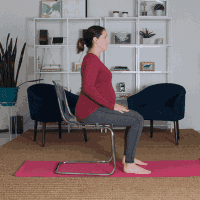Pregnancy is a journey of anticipation and joy, where every flutter and kick reminds you of the life blossoming within. However, amidst the glow and excitement, it also brings a mosaic of unexpected discomforts. One such discomfort, often overlooked, is the sharp, radiating pain known as sciatica. This pain isn’t just an ordinary ache; it’s a jolt that can catch you off-guard, making even the simplest activities a challenge. If you’re an expectant mother experiencing this unique form of distress, you’re not alone. Many women grapple with sciatica during pregnancy, seeking clarity and relief. This guide is tailored for you, offering insights into why sciatica surfaces during pregnancy and, most importantly, how you can navigate and cope with its challenges.
Contents
Understanding Sciatica: A Primer
 Sciatica is more than just a backache; it’s a symptom of an underlying issue affecting the sciatic nerve, the longest nerve in your body. This nerve runs from the lower spine, through the buttocks, down to the back of each leg. When this nerve is irritated or compressed, the result is a characteristic pain known as sciatica. Let’s delve a bit deeper:
Sciatica is more than just a backache; it’s a symptom of an underlying issue affecting the sciatic nerve, the longest nerve in your body. This nerve runs from the lower spine, through the buttocks, down to the back of each leg. When this nerve is irritated or compressed, the result is a characteristic pain known as sciatica. Let’s delve a bit deeper:
- Nature of the Pain: Sciatica typically causes a sharp, burning pain that radiates from the lower back or buttock down one leg, sometimes even reaching the foot. It can be accompanied by tingling, numbness, or muscle weakness in the affected leg.
- Why It’s a Concern During Pregnancy: Pregnancy introduces numerous changes to a woman’s body, some of which can increase the risk of developing sciatica. The growing uterus can put pressure on the sciatic nerve. Additionally, hormonal changes can cause the ligaments that support your spine to loosen, making it more susceptible to nerve compression.
- Not Just a Regular Pregnancy Back Pain: While back pain is common in pregnancy, sciatica has a distinct quality. Its sharp, shooting nature sets it apart from the typical aches and pains of pregnancy.
Understanding sciatica is the first step in managing it. For expectant mothers, it’s vital to distinguish between regular pregnancy discomfort and potential sciatica, ensuring timely and appropriate care.
Why Pregnancy Can Trigger Sciatica?

Pregnancy is a transformative experience that brings joy, anticipation, and unfortunately, for some, discomforts like sciatica. While sciatica can affect anyone, pregnant women are especially susceptible due to a series of physiological changes they undergo. Let’s explore the main culprits:
- Weight Gain: As the baby grows, an expectant mother naturally gains weight. This additional weight increases the strain on the spine and can cause the discs between the vertebrae to compress, potentially pinching the sciatic nerve.
- Hormonal Changes: During pregnancy, the body releases a hormone called relaxin. While relaxin is crucial for preparing the pelvis for childbirth by loosening the ligaments, it can also loosen the ligaments supporting the spine. This increased laxity can lead to misaligned vertebrae or discs, which may press against the sciatic nerve.
- Shifting Center of Gravity: As the baby bump grows, a woman’s center of gravity moves forward. To compensate, many women may arch their backs, a posture that can place extra pressure on the lower spine and irritate the sciatic nerve.
- Baby’s Position: In some cases, the baby might settle into a position that puts direct pressure on the sciatic nerve. This is often temporary and changes as the baby shifts and grows.
- Increased Blood Volume and Water Retention: Pregnancy leads to an increase in blood volume and often, fluid retention. This can result in swelling, which might press against the sciatic nerve.
Understanding these triggers is essential for pregnant women to take preventive measures and seek early interventions, ensuring that they can enjoy this special phase of life with minimal discomfort.
Common Symptoms and Signs in Expectant Mothers
Sciatica during pregnancy can present in a myriad of ways, and while some symptoms may overlap with general pregnancy discomforts, others are distinctly associated with sciatica. Being able to differentiate between these symptoms can aid in early diagnosis and management:
- Sharp, Shooting Pain: Sciatica is often characterized by a sudden sharp pain that radiates from the lower back or buttock down the back of the leg, following the path of the sciatic nerve. This pain can be intermittent or constant.
- Numbness and Tingling: Some women might not experience sharp pains but could notice a tingling sensation or numbness in the buttock, thigh, or calf region.
- Weakness in the Affected Leg: The leg affected by sciatica might feel weak or fatigued, especially after prolonged standing or walking.
- Burning Sensation: Apart from sharp pains, a burning sensation along the nerve path is another hallmark symptom of sciatica.
- Localized Lower Back Pain: While many pregnant women experience lower back pain due to the weight of the growing baby, sciatica-related back pain is more localized and can be exacerbated by specific movements.
- Pain Worsens with Movement: Activities like standing up after sitting, bending forward, or even sneezing and coughing can intensify sciatic pain.
- Pain Relief in Certain Positions: Some women find relief from sciatic pain when lying down, especially on the opposite side of the affected leg, or by elevating the affected leg.
Distinguishing these symptoms from general pregnancy aches is crucial. While mild swelling of feet or general discomfort in the back might be common in pregnancy, the sharp, radiating pain or persistent numbness typical of sciatica warrants attention and appropriate management.
Safe and Effective Pain Management Techniques
 Dealing with sciatica pain during pregnancy can be challenging, especially since many medications are off the table due to potential risks to the baby. However, there are several non-pharmacological methods that can offer significant relief without compromising the safety of both mother and child:
Dealing with sciatica pain during pregnancy can be challenging, especially since many medications are off the table due to potential risks to the baby. However, there are several non-pharmacological methods that can offer significant relief without compromising the safety of both mother and child:
- Posture Corrections: Maintaining a proper posture, especially while sitting or standing, can greatly reduce the strain on the lower back and sciatic nerve. Using pillows to support the lower back while sitting, ensuring the feet are flat on the ground, and avoiding crossing the legs can be beneficial.
- Warm and Cold Compresses: Applying a cold pack can help reduce inflammation, while a warm pack can soothe muscle tension. It’s essential to avoid applying extreme temperatures directly to the skin—always use a cloth or towel as a barrier.
- Prenatal Massage: A trained prenatal massage therapist can target areas of tension and provide relief. This therapy not only addresses sciatica pain but also offers overall relaxation during pregnancy.
- Wear Supportive Footwear: High heels or unsupportive shoes can exacerbate sciatica symptoms. Opting for footwear with good arch support and a cushioned sole can make a noticeable difference.
- Avoid Prolonged Standing or Sitting: Changing positions frequently and taking short, frequent breaks to walk or stretch can prevent added pressure on the sciatic nerve.
- Belly Support Belts: These belts help distribute the weight of the growing baby more evenly, relieving pressure from the lower back and pelvis, which in turn can alleviate sciatic pain.
While these techniques offer relief, targeted exercises can further help in managing and reducing the symptoms of sciatica during pregnancy. These exercises, which we’ll delve into in the next section, are specifically designed with the pregnant body in mind and aim at strengthening and stretching the areas most affected by sciatica.
Exercises to Strengthen and Relieve
Exercising during pregnancy has numerous benefits, especially when tailored to address specific concerns like sciatica. Here are a few exercises particularly beneficial for expectant mothers dealing with sciatica. Remember, always consult with a healthcare provider before starting any new exercise regimen during pregnancy.
Pelvic Tilts

How to do it:
- Start by lying on your back with your knees bent and feet flat on the floor.
- Flatten your lower back against the floor by tightening your abdominal muscles.
- Tilt your pelvis up slightly, hold for a few seconds, then relax.
- Repeat 10-15 times.
Prenatal Yoga: Child’s Pose
How to do it:
- Begin on your hands and knees in a tabletop position.
- Sit your hips back while reaching your arms forward on the floor.
- Rest your forehead on the ground. If comfortable, widen your knees to allow more space for your belly.
- Hold for 20-30 seconds and return to the starting position.
Seated Piriformis Stretch

How to do it:
- Sit on a chair with both feet flat on the floor.
- Cross your affected leg over the other, placing the ankle on the opposite knee.
- Gently press down on the raised knee and lean forward slightly, ensuring your back remains straight.
- Hold for 15-30 seconds, then switch sides.
Cat-Cow Stretch
How to do it:
- Start on your hands and knees in a tabletop position.
- Inhale as you arch your back (cow position) and look upwards.
- Exhale as you round your spine (cat position) and tuck your chin towards your chest.
- Continue the flow between these positions for about 1 minute.
Knee-to-Chest Stretch

How to do it:
- Lie on your back on a comfortable surface, preferably a yoga mat.
- Bend one knee and hug it gently towards your chest, using your hands.
- Hold for 20-30 seconds, feeling a stretch in your glutes and lower back.
- Release and switch to the other leg.
While these exercises can provide relief, it’s crucial to listen to your body. If any movement causes additional pain or feels uncomfortable, stop immediately and consult with a healthcare provider or physiotherapist.
When Medication Might Be Necessary
 While many expectant mothers aim to avoid medications, there are times when the severity of sciatica pain might necessitate a pharmaceutical approach. Here’s a breakdown of the scenarios and the associated considerations:
While many expectant mothers aim to avoid medications, there are times when the severity of sciatica pain might necessitate a pharmaceutical approach. Here’s a breakdown of the scenarios and the associated considerations:
- Over-the-Counter (OTC) Pain Relievers:
- Paracetamol (Acetaminophen) is generally considered safe during pregnancy in recommended doses.
- NSAIDs (Non-Steroidal Anti-Inflammatory Drugs), such as ibuprofen, should typically be avoided, especially during the third trimester, as they can pose risks to the fetus.
- Topical Pain Relievers: Creams and gels containing counterirritants (e.g., menthol or camphor) can be applied to the affected area.
- Prescription Medications: In severe cases, where pain is debilitating, your doctor might prescribe stronger pain relievers or muscle relaxants. Their usage should be short-term and under strict medical supervision, considering both the mother’s comfort and fetal safety.
- Prenatal Vitamins: Deficiencies in certain vitamins and minerals, such as magnesium, might exacerbate muscle cramps and pain. Ensuring an adequate intake can sometimes help in alleviating symptoms.
Always discuss any medications or supplements with your healthcare provider. While the goal is to manage pain, the safety of both mother and baby remains paramount.
Conclusion
Navigating the challenges of pregnancy can be overwhelming, especially when coupled with the discomfort of conditions like sciatica. Remember, you’re not alone in this journey. Many have trodden this path before you, finding relief and solutions to manage the pain effectively. Physical therapy stands out as one of those reliable allies, offering specialized techniques tailored to your unique situation.
Physical Therapy helps patients recover from pain. If you’re experiencing Back, Shoulder, Knee, Neck, Elbow, Hip, or Arthritis pain, physical therapist at PhysioMantra can help: Book an online physical therapy session.



